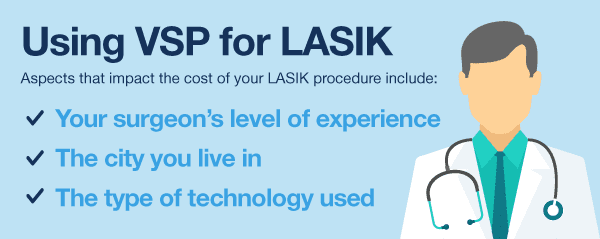Does VSP Cover LASIK?
Home / Cost of LASIK Surgery /
Last Updated:
VSP, or Vision Service Plan, is a health insurance provider that covers many Americans. VSP offers discounts for many types of vision surgery, including LASIK.
Table of Contents
Key Facts About Lasik Eye Surgery Cost With Insurance VSP
- VSP plans typically cover medically necessary procedures. LASIK is considered elective, so costs aren’t 100% covered.
- Some VSP plans provide coverage for LASIK through the VSP Laser VisionCare Program or the VisionCare Preferred Program.
- VSP encourages patients to combine available insurance and payment options to reduce out-of-pocket costs.
Is LASIK Covered by VSP?
VSP offers dozens of different insurance plans, and each one works differently. Some of them provide coverage for LASIK. If your plan includes LASIK benefits, your costs are capped. You’ll never pay more than a contracted amount for surgery.
You deserve clear vision. We can help.
With 135+ locations and over 2.5 million procedures performed, our board-certified eye surgeons deliver results you can trust.
Your journey to better vision starts here.
LASIK eye surgery is a permanent correction for common vision problems like nearsightedness and farsightedness. After LASIK, you may not need glasses or contacts at all. But insurance companies often consider this an elective procedure, as glasses and contacts work well and are less expensive.
Your price can vary. Your surgeon’s level of experience, the city you live in, and the type of technology used can all impact the cost of your LASIK procedure. Other aspects that affect cost include the following:
- Required vision correction: People who have higher rates of refractive errors require more planning on the surgeon’s part and more time for the operation. In rare cases, the thinness of your cornea or the severity of your refractive error will mean you are not a candidate for LASIK. As technology advances, this is becoming less of a problem, but it still means you will get less coverage from vision insurance and spend more money out of pocket.
- Laser technology: Newer and custom LASIK devices require updated training for the surgeons who use them. The cost of this training, along with updating the hardware, can impact your cost as the patient.
- Surgeon skill: Surgeons who spend a lot of time keeping their training up to date and who have many specialized patients tend to cost more than those who are newer, who work in group practices, or who do not have specialized training in specific forms of LASIK or LASIK devices.
VSP insurance was founded in 1955 to help people get glasses, eye exams, and needed eye surgeries. The VSP Laser Vision Care Program offers insurance for vision correction surgeries like LASIK.
Benefits Within the VSP Laser Vision Care Program
Work with a VSP preferred provider, and your initial LASIK screening is complimentary. But you’ll need a VSP Laser Vision Care plan to pay for the surgery.
If you have this plan, you must work with a VSP preferred provider. Your surgery cost is capped, so you won’t pay more than a set amount for your procedure – and your coverage could get you a discounted rate.

How to Determine if Your VSP Plan Covers LASIK
All VSP plans use a network, or a set of providers with financial agreements with VSP. Staying within that network keeps your cost down. Other plan details can vary.
- Deductible: the amount of money you must pay out of pocket before your insurance company starts to pay
- Coinsurance. the amount you pay for healthcare benefits after you meet your deductible
- Copayment: your cost-sharing payment that is due when you use your plan benefits (like seeing a doctor)

Your insurance plan details are contained within a Summary of Benefits and Coverage document issued with your plan. You can also call VSP directly or use the company website to understand your benefits.
If you’re interested in LASIK, schedule a LASIK consultation. Undergo a detailed examination to determine if you’re a good candidate for surgery. Find out about the risks and benefits of this form of permanent vision correction, and learn more about how your benefits work.
Types of LASIK that may be covered include LASIK and custom LASIK. Your doctor can help you decide which form of surgery is right for you.
It’s important to work with a qualified LASIK provider that accepts VSP payments. Your conversation begins a partnership that can result in better vision for a lifetime.
You deserve clear vision. We can help.
With 135+ locations and over 2.5 million procedures performed, our board-certified eye surgeons deliver results you can trust.
Your journey to better vision starts here.
How to Manage LASIK Costs Not Covered by VSP
The national average cost of LASIK without insurance is around $2,600 per eye, but NVISION’s partnership with VSP could mean significant savings on your procedure.
As a VSP member, you may be eligible for exclusive discounts on LASIK and PRK, with additional financing options like FSAs, HSAs, credit cards, and flexible payment plans to help make vision correction more affordable. Many patients find they can combine these options to maximize their savings. Curious about how much you could save? Contact NVISION today to explore your potential benefits through VSP!
VSP & LASIK Frequently Asked Questions
Yes. NVISION accepts this form of insurance.
Many insurance providers consider LASIK an elective surgery (not a cosmetic one).
VSP allows doctors to determine if the surgery is appropriate for a patient or not. The surgeon chooses which surgery is best for the patient.
You deserve clear vision. We can help.
With 135+ locations and over 2.5 million procedures performed, our board-certified eye surgeons deliver results you can trust.
Your journey to better vision starts here.
References
- VSP Claims at a Glance. (September 2022). Centers for Disease Control and Prevention.
- The 25th Anniversary of Laser Vision Correction in the United States. (March 2021). Clinical Ophthalmology.
- LASIK With VSP Insurance. VSP Insurance.
This content is for informational purposes only. It may have been reviewed by a licensed physician, but is not intended to serve as a substitute for professional medical advice. Always consult your healthcare provider with any health concerns. For more, read our Privacy Policy and Editorial Policy.

